
Wine Culture and Information since 2002 - Volume 22
 Wine Culture and Information since 2002 - Volume 22 |
|
Issue 114, January 2013 |
Contents |
|
|
Wine Wars |
|
This is a story as old as wine, probably originated the day the beverage of Bacchus became part of the culture and evolution of mankind. I already discussed about this subject - something which is probably not beneficial to wine in general - but, as it seems, there is no way to find a peaceful solution. Disputes, diatribes, arguments - frequently supported with no reason and with no competence or knowledge about the subject - start a fire among wine lovers, sometimes even started by the producers themselves. Disputes about wine follow the fate of fashions that, periodically, are poured on the glasses and keep alive the arguments. Passionate supporters line up with one or the other side, frequently the choice of sides goes beyond the two simple alternatives, causing clashes - most of the times of ideological type, almost religious - which seem to have no end. And in case they get to an end, it frequently is because other disputes have been arisen, replacing old fashions and pride, but with the result of keeping alive the yelling of the many, strenuously busy to have their own reasons prevailing over the ones of others. Objections are made, hurling abuses at everyone, with the only and evident goal: to show, frequently in a blind and hypocrite way, to be right and whoever thinks differently is an ugly, bad and dishonest person. Let's consider producers first, while saying - in a clear way - that, in any case, also when I do not agree on their positions, I always respect, however and in any case, their job and the wines they make, also in case, in an exclusively personal opinion, I don't like them. Respect first of all and above all, arrogance, on the other hand, never justified. Speculation is never justified as well, both ideological and economic. Let's make this clear, once again: making wine, quality wine, is onerous both in economic terms and of resources, therefore it is more than legitimate, as well as wished, profit is one of the main goals. After all, a winery is not a voluntary organization with sincere and noble humanitarian and social goals: it is an enterprise. This is something which should also be understood by consumers, in particular those who associate to wine natural, aulic and romantic feelings only. Producers, like to say, are in a certain way forced to support their job and their wines. An unavoidable and understandable choice, also in case it is supported in a sincere and honest way: if producers are not the first ones to believe on their job, it will not certainly be consumers. Moreover, in case these choices are not supported with sincerity and honesty, producers tend to be very polemical and “ferocious” against the producers who do not agree on their choices and on the same way to make and see wine. The result leads to ideological clashes, blaming each other for the reciprocal dishonesty while considering themselves as the only and unique guard of the real wine and of the real way to make wine. Each of them believes to be the authentic repository of an art - which is realized also thanks to science and knowledge, both being never enough, never right - a fierceful defender of “nature” and of a supposed moral, cultural and intellectual integrity. This is something making me smile, in particular if we consider the fact wine does not exist in nature, it is not an invention of “Mother Nature”, it simply is a beverage created by man by interacting with processes Nature uses for its own advantage. Nature is not interested in wine at all, not even the humble vine, which we have forced to live in a way, in an environment and for a goal not belonging to it and that Nature did not assign to it. Of course, we all are very happy to know from the golden and purple bunches of grapes can be obtained a noble and inebriating beverage like wine. Or a strong and vigorous condiment like vinegar. As well as a pleasing and sweet juice, to be drunk as soon as it is extracted from crushed berries. Around to what men can obtain from vine have started fierceful wars, all having the goal of asserting the very same thing, although expressed in different forms: proving to be the best. Most of the times, it seems so difficult to understand, as well as having the doubt, that in case the “best” really exists, there is not only one way to be “the best”. Some support the idea wine should be kept away from chemistry, while forgetting wine is also the inevitable result of chemical processes. Some support the idea modern technology is the absolute evil in wine and it should be kept the tradition of past times only, while forgetting past times are just such and, in case this would be possible, no one would probably accept to live like that while renouncing to what progress and time brought to men. Including what it brought to wine, viticulture and enology. Besides being fierceful and ruthless, the debate quickly deteriorates as there are many, maybe too much, school of thoughts, philosophies, enlightened enological sects, each of them - in its own logic - exact and indisputable. After all, religions are like that. Diatribes find a natural megaphone in many communication media, including social networks, where many, maybe too much, and, last but not the least, with no competence or knowledge about the subject, “blow their own trumpet”, supporting and passionately defending the cause which becomes an intimate part of themselves. Difference and diversity are priceless heritages, an endless richness beneficial to all, an extraordinary resource for comparison, for the development and improvement of everything. Words spoken only because they must be spoken, without being in the condition of supporting them with real and concrete facts, are useless. They only prove the “subjection of silly servant” to the service of others, while having the illusion, empty and useless, of being “important”, part of a “group of enlightened ones” which in that moment is considered to be the more convenient one. These subjects, frequently have presumptuous attitude and of disgusting arrogance, convinced of the fact that what they say is the incontrovertible, absolute and revealed truth. The conflict becomes a way to support one's own pride, with the only goal of safeguarding one's position in the aim of winning the clash. It is completely useless to express an opinion: in case it is contrary to the one of others, the invective enters the scene to defend the lese-majesty. What wine has to do with all that? Nothing. Absolutely nothing. At the end everyone keeps the respective position, everyone continues to prefer one or the other wine, one or the other enological religion, also for continuing to support one's pride and to show others to be on the right side. What remains is an endless debate leaving a pile of rubble, rubble of nothing. To read the words of certain “fights”, it makes this question to come to mind: are we really sure we understood what is wine? Are we really sure these endless debates, in which everyone is however inflexibly convinced of their opinions, is something beneficial to wine? I don't think so. We need a meeting point and to join intents, because if it is true wine and its territories have failed in some aspects, it is mainly because of the endless divisions - of producers, consumers and writers - in supporting the concept, stupidly and blindly, the grass certainly is less green on the other side. Antonello Biancalana
|
||||
Emotional TastingWine is tasted in different ways, according to the context in which the bottle is being uncorked. In particular, according to the reliability of the result to be produced |
|
There are many ways to taste a wine. The discriminating factor is, with no doubt, the reliability of the result to be produced by the evaluation. Moreover, the use to be done of what is perceived from the glass. Sensorial and organoleptic tasting of a wine can be done for many reasons, from purely personal and absolutely subjective reasons, as well as objective ones in order to determine the correspondence of a wine to specific criteria, or to assess its objective quality. The discriminating factor, despite of the goal of the tasting, is represented by the fact of knowing the wine to be evaluated in advance. To know what wine is about to be tasted, represents - however and in any case - an element of influence for the objectivity and reliability of the result. To know in advance the wine to be tasted, completely changes both the evaluation method, as well as the psychological and relational predisposition towards a specific wine. It is undeniable every taster uses his or her own method of evaluation, every one uses a method of personal relation with a wine, using procedures and strategies developed and improved with time and experience. There are, and this is undeniable as well, methods and criteria universally agreed and used by almost every taster, methods that, with time, have proven their reliability in a concrete way, although - like everything - they should not be considered as absolute and indisputable. Everything can be improved, of course, including the technique of sensorial tasting, not only related to wine. In every case, the way with which the content of a glass is being evaluated, and how it is being considered, radically changes both the thought and opinion which one can have or form about a specific wine. Every time a wine is tasted and it is known in advance, conditions influencing its judgment will take place. This in fact guides our emotions towards a certain direction, strongly influenced by the personal relationship and prejudices the taster has towards all the known factors. To clear things, we are not asserting the tasting of a wine which is known in advance should not be done, however, it should be considered its reliability is very low. For example, it should be considered the disappointment sometimes happening after having bought a wine in a winery - and tasted in that place before buying it - that, as it is tasted outside that context, it will not taste as good or amazing as it was supposed to be. The emotional involvement of being in the place where the wine is being produced, that for many represents a rare and unusual event, positively prepares towards the wines which will be tasted, as well as judging them better than they are for real.
The tasting of a wine of which are known in advance its characteristics, is technically called unblind tasting. Its opposite - blind tasting - is achieved by scrupulously keeping hidden and unknown all the identifying elements of a wine, with the exception of style, as this can be easily recognized by a quick observation of the glass. Sometimes, in blind tasting - according to its application, usually in wine contests - are also provided other identifying elements, such as wine making style and aging condition. Blind tasting, and this mainly depends by the aptitude of the taster, must not be seen as an detached or impersonal practice, as it is absolutely normal and understandable that during the evaluation of a wine emotions will develop. Undoubtedly, the perception of a clean and pleasing aromas, will positively predispose a taster towards a certain wine, whereas an unpleasing aromas will drastically compromise its agreeability as well as the result. In order to not compromise the objectivity of the result, in blind tasting it is common to not show the bottle to the taster, as this represents a remarkable identifying element represented by its shape. A Rhine bottle, for example, directs the taster towards specific wines, mainly produced in Alsace or in the Rhine, however to wines which can be associated to that style. Likewise, an Albeisa bottle, directs the taster towards wines produced in the Langhe area, in particular the ones produced with Nebbiolo grape. It is undeniable producers, with the exception of some commercial cases or for image purposes, tend to bottle their wines in bottles having “coded” shapes and which can be associated to a specific style. Bordelais bottle is mainly used for red wine having a good or full body, as well as for full bodied white wines, whereas Burgundy bottle is frequently used for elegant red wines - in particular, Pinot Noir - as well as medium bodied white wines. There are many factors capable of significantly influencing the evaluation of a wine, most of the times in a strong positive or negative way. Let's try to understand the main factors and how they can affect the sensorial and emotional process of tasting. Let's start from the places where the wine is created, or better to say, evolves: winery. Visiting a winery, even better, the vineyards of a producer, certainly is a highly educational and suggestive experience. On this regard - it should be said and remembered - visiting a winery and focusing on the tasting of wines only, maybe in a specific room, without having the chance of visiting vineyards, in particular when they are in their full vegetative process, the visit loses most of its charm and meaning. Not less important, to visit a winery without having the chance to see the places where the grape is being transformed into wine and is kept until the moment of bottling. These conditions - it should be said - despite representing a high and unique chance for understanding a wine, its produces and the places in which it is being produced, however adds an element of “disturb” at the moment of the tasting of those wines and in those places. This type of disturb generally predisposes to a positive evaluation of a wine, with a strong emotional involvement following the visit in vineyards, winery, and the pleasure of being in the places where those wines are being produced, conditions which are certainly uncommon in the daily life of most of visitors. To this is also added, of course, the presence of the producer who - understandably - reinforces the involvement of the visitor by talking about his or her job, the places and how he or she makes wine, the productive philosophy and, in a more or less convincing way, of what will be found in the glass at the moment of tasting the wines. Listening to the producer's words while he or she is telling about vineyards, winery and the wines he or she makes, certainly is a privilege to which would be unforgivable to renounce during the visit. This is an unavoidable aspect, and fundamental, during the visit to a winery, as well as a strong prejudicial element which will influence the tasting of the producer's wines, frequently predisposing the result in a positive way. It can in fact happen that, the very same wine tasted in the winery and with the producer, when tasted in a different context, or blind tasted, gives a very different result, disappointing the pleasing memory of the visit to that winery. Disappointment which could be lesser, as well as strengthening the memory of the visit, in case the same wine is being tasted when it is known what we are going to pour on the glass. In that case, will be the pleasing memory and emotions lived during the visit to the winery to affect our positive predisposition towards that wine. Of course, we are not saying wines tasted in the winery are considered better than they are for real, however it is undeniable this specific condition remarkably affects its agreeability. The tasting done on one's own or in company of others, generally gives quite different results. Solitary tasting forces, like to say, to a more direct and contemplative relationship with the glass and its content, a condition generally not happening when the same wine is being tasted in company of friends. In fact, in these contexts, multiple conditions frequently take place, distracting the taster from the real content of the glass, and the condition of being together generally becomes dominant and, frequently, also the will to become the leading figure in that group may happen. In other words, a wine it is not tasted with the spirit of determining its real profile, indeed, the persons are mainly focused to a sort of competition with the goal of proving one's own talent and skill which will unavoidably end up to influence the perception of others. The subject of wine usually involves the pride of the consumer, both for reasons associated to tradition and culture, as well as for showing one's knowledge, presumed or real, to the others. For this reason, in group tasting, it will be the opinion of the person considered to be the “more competent” to influence the opinion of others. In case in the group are present two or more “experts”, competition and confusion of others will happen for sure. Emotional tasting is sometimes used for expressing concepts, ideas and feelings which are alien to wine and its world, but use the beverage of Bacchus as a pretext and as a way of expression. Wine is in fact used to evoke views, emotions and feelings, to tell stories having no connection to wine, but seeming to have with wine, in that moment and like a tale, a sort of connection. In this case enter the scene animals, plants, places and the most bizarre suggestions, adjectives and substantives, used for showing off one's skill of eloquence and of literary talent, most of the times completely out of the context of wine. If it is true that in sensorial tasting - in particular in the olfactory evaluation of a wine - for the description of an aroma it is used the association with “known” elements instead of referring to the molecule producing that smell, sometimes the association is excessive and the account seems to talk about something else while pretending to talk about wine. In these cases, to know the wine to be tasted in advance, strongly helps the evocative and emotional process, even directing the search of terms used for the description. The result, from a “technical” point of view, is however negligible and not reliable at all, moreover, it is affected by the personal prejudice or predisposition towards a specific wine, specific grapes, producers, places and wine styles. Another prejudice affecting the result of emotional tasting, is the personal relationship one has with specific producers, grapes and wine making areas. For example, in case a taster has a predilection for Merlot, the taste of any wine produced with Merlot grape will certainly have a better consent in case this factor is revealed in advance. Likewise, in case a grape is not liked by the taster, by knowing in advance the wine to be tasted is produced with that grape, this would determine an adverse and prejudicial attitude. The same happens for any other factor: for example, the blind position of denigrating wines of a certain area - usually for purely local pride - usually brings to the exaltation of the wines produced in the area of the taster or for which the taster has an unconditional admiration. Emotional tasting greatly simplify the process of wine evaluation, with that, also the reliability and trustworthiness of the result. This does not mean every wine must be blind tasted, however it should be considered the result of emotional tasting is always and in every case affected by disturbing elements compromising its reliability.
|
||||||||||||
Wines of the Month |
|
|
|
Score legend Prices are to be considered as indicative. Prices may vary according to the country or the shop where wines are bought |
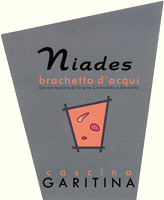
|
|
Brachetto d'Acqui Niades 2011 |
|
| Cascina Garitina (Piedmont, Italy) | |
| Grapes: Brachetto | |
| Price: € 10.00 | Score: |
| Brachetto d'Acqui Niades shows a pale ruby red color and nuances of cherry pink, moderate transparency. The nose denotes intense, clean, pleasing and refined aromas which start with hints of grape, strawberry and cherry followed by aromas of raspberry, rose, cyclamen, carnation, blueberry and blackberry. The mouth has good correspondence to the nose, an effervescent and sweet attack, however balanced by alcohol, light body, intense flavors, pleasing crispness. The finish is persistent with flavors of grape, strawberry and cherry. Brachetto d'Acqui Niades ferments at a low temperature in fridge for about 10 days. | |
| Food Match: Semifreddo, Fruit desserts | |
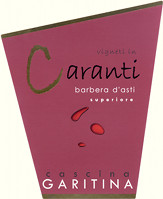
|
|
Barbera d'Asti Superiore Caranti 2009 |
|
| Cascina Garitina (Piedmont, Italy) | |
| Grapes: Barbera | |
| Price: € 9.50 | Score: |
| Barbera d'Asti Superiore Caranti shows an intense ruby red color and nuances of garnet red, little transparency. The nose denotes intense, clean, pleasing and refined aromas which start with hints of cherry, plum and blackberry followed by aromas of violet, blueberry, vanilla, cocoa, mace, tobacco and menthol. The mouth has good correspondence to the nose, a properly tannic attack and however balanced by alcohol, good body, intense flavors, pleasing crispness. The finish is persistent with flavors of cherry, plum and blackberry. Barbera d'Asti Superiore Caranti ages in cask for 13 months followed by 3 months of aging in bottle. | |
| Food Match: Roasted meat, Broiled meat and barbecue, Stewed meat with mushrooms, Hard cheese | |
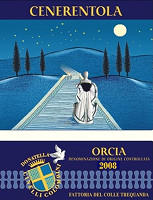
|
|
Orcia Rosso Cenerentola 2008 |
|
| Donatella Cinelli Colombini (Tuscany, Italy) | |
| Grapes: Sangiovese (65%), Foglia Tonda (35%) | |
| Price: € 23.00 | Score: |
| Orcia Rosso Cenerentola shows an intense ruby red color and nuances of garnet red, moderate transparency. The nose reveals intense, clean, pleasing and refined aromas which start with hints of black cherry, blackberry and plum followed by aromas of blueberry, dried violet, vanilla, tobacco, chocolate and mace. The mouth has good correspondence to the nose, a properly tannic attack and however balanced by alcohol, good body, intense flavors, agreeable. The finish is persistent with flavors of plum, black cherry and blackberry. Orcia Rosso Cenerentola ages for 12 months in cask. | |
| Food Match: Carne arrosto, Carne alla griglia, Stufati di carne con funghi, Formaggi stagionati | |
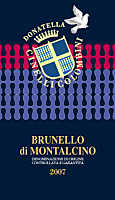
|
|
Brunello di Montalcino 2007 |
|
| Donatella Cinelli Colombini (Tuscany, Italy) | |
| Grapes: Sangiovese | |
| Price: € 28.00 | Score: |
| This Brunello di Montalcino shows a brilliant ruby red color and nuances of garnet red, moderate transparency. The nose denotes intense, clean, pleasing and refined aromas that start with hints of plum, black cherry and dried violet followed by aromas of raspberry, blueberry, chocolate, vanilla, dried rose, mace and menthol. The mouth has good correspondence to the nose, a tannic attack and however balanced by alcohol, full body, intense flavors, agreeable. The finish is persistent with flavors of black cherry, plum and raspberry. This Brunello di Montalcino ages in cask. | |
| Food Match: Game, Roasted meat, Stewed and braised meat, Hard cheese | |
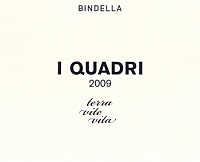
|
|
Vino Nobile di Montepulciano I Quadri 2009 |
|
| Bindella (Tuscany, Italy) | |
| Grapes: Sangiovese | |
| Price: € 22.00 | Score: |
| Vino Nobile di Montepulciano I Quadri shows a brilliant ruby red color and nuances of garnet red, moderate transparency. The nose reveals intense, clean, pleasing, refined and elegant aromas which start with hints of black cherry, plum and violet followed by aromas of blueberry, blackberry, tobacco, vanilla, chocolate, cinnamon, mace and menthol. The mouth has good correspondence to the nose, a tannic attack and however balanced by alcohol, full body, intense flavors, agreeable. The finish is persistent with flavors of black cherry, plum and blackberry. Vino Nobile di Montepulciano I Quadri ages for 18 months in cask followed by 6 months of aging in bottle. | |
| Food Match: Game, Stewed and braised meat, Roasted meat, Hard cheese | |

|
|
Vin Santo di Montepulciano Dolce Sinfonia 2007 |
|
| Bindella (Tuscany, Italy) | |
| Grapes: Trebbiano Toscano (80%), Malvasia Bianca (20%) | |
| Price: € 25.00 - 375ml | Score: |
| Vin Santo di Montepulciano Dolce Sinfonia shows an intense amber yellow color and nuances of amber yellow, moderate transparency. The nose reveals intense, clean, pleasing, refined and elegant aromas that start with hints of raisin, dried apricot and dried fig followed by aromas of peach jam, almond, lavender, quince jam, walnut, date, vanilla, citrus fruit peel, tobacco, candied fruits and nail polish. The mouth has excellent correspondence to the nose, a sweet and round attack, however balanced by alcohol, good body, intense flavors, pleasing crispness. The finish is very persistent with long flavors of raisin, dried apricot and honey. Vin Santo di Montepulciano Dolce Sinfonia ages for at least 36 months in “caratelli” barrels followed by 12 months of aging in bottle. | |
| Food Match: Confectionery, Dried fruit tarts, Hard and piquant cheese | |
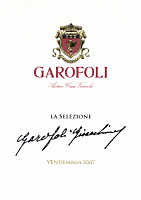
|
|
Rosso Conero Riserva Selezione Gioacchino Garofoli 2007 |
|
| Garofoli (Marches, Italy) | |
| Grapes: Montepulciano | |
| Price: € 41.00 | Score: |
| Rosso Conero Riserva Selezione Gioacchino Garofoli shows a deep ruby red color and nuances of ruby red, little transparency. The nose reveals intense, clean, pleasing, refined and elegant aromas which start with hints of black cherry, blackberry and plum followed by aromas of violet, blueberry, vanilla, tobacco, carob, chocolate, cinnamon, licorice, tobacco and eucalyptus. The mouth has excellent correspondence to the nose, a tannic attack and however balanced by alcohol, full body, intense flavors, pleasing roundness. The finish is very persistent with long flavors of blackberry, black cherry and plum. Rosso Conero Riserva Selezione Gioacchino Garofoli ages for 18 months in barrique followed by about 30 months of aging in bottle. | |
| Food Match: Game, Roasted meat, Stewed and braised meat, Hard cheese | |
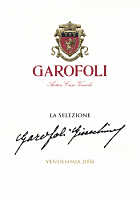
|
|
Verdicchio dei Castelli di Jesi Classico Riserva Selezione Gioacchino Garofoli 2006 |
|
| Garofoli (Marches, Italy) | |
| Grapes: Verdicchio | |
| Price: € 27.50 | Score: |
| Verdicchio dei Castelli di Jesi Classico Riserva Selezione Gioacchino Garofoli shows a brilliant golden yellow color and nuances of straw yellow, very transparent. The nose reveals intense, clean, pleasing, refined and elegant aromas which start with hints of apple, plum and almond followed by aromas of ripe peach, honey, hazelnut, hawthorn, citrus fruits, broom, pineapple, pear and mineral. The mouth has excellent correspondence to the nose, a crisp attack and however balanced by alcohol, full body, intense flavors, pleasing roundness. The finish is very persistent with long flavors of apple, plum and ripe peach. Verdicchio dei Castelli di Jesi Classico Riserva Selezione Gioacchino Garofoli ages for 18 months in steel tanks followed by at least 6 months of aging in bottle. | |
| Food Match: Roasted white meat, Roasted fish, Stewed fish, Stuffed pasta with mushrooms | |
News |
|
In this section are published news and information about events concerning the world of wine and food. Whoever is interested in publishing this kind of information can send us a mail to our address.
|
AquavitaeReview of Grappa, Distillates and Brandy |
|
|
| Distillates are rated according to DiWineTaste's evaluation method. Please see score legend in the "Wines of the Month" section. |
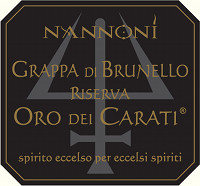
|
|
Grappa di Brunello Riserva Oro dei Carati |
|
| Nannoni (Tuscany, Italy) | |
| Raw matter: Pomace of Brunello di Montalcino | |
| Price: € 50.00 - 70cl | Score: |
| Grappa di Brunello Riserva Oro dei Carati shows an intense golden yellow color, limpid and crystalline. The nose reveals intense, clean, pleasing, refined and elegant aromas of chocolate, dried fig, hazelnut, licorice, prune, walnut, tobacco, honey and dried violet, with almost imperceptible alcohol pungency. In the mouth has intense flavors with perceptible alcohol pungency which tends to dissolve rapidly, excellent correspondence to the nose, balanced sweetness, pleasing roundness. The finish is very persistent with long flavors of chocolate, dried fig, prune and hazelnut. Grappa di Brunello Riserva Oro dei Carati is distilled in a batch steam operated alembic still and ages for 5 years in Limousine oak barrique. | |
Wine Parade |
|
|
| The best 15 wines according to DiWineTaste's readers. To express your best three wines send us an E-mail or fill in the form available at our WEB site. |
| Rank | Wine, Producer | |
|---|---|---|
| 1 |
| Franciacorta Pas Dosé Récemment Dégorgé 2006, Cavalleri (Italy) |
| 2 |
| Sagrantino di Montefalco Collepiano 2007, Arnaldo Caprai (Italy) |
| 3 |
| Adarmando 2009, Tabarrini (Italy) |
| 4 |
| Avvoltore 2009, Moris Farms (Italy) |
| 5 |
| Batàr 2008, Querciabella (Italy) |
| 6 |
| Gran Masetto 2007, Endrizzi (Italy) |
| 7 |
| Trento Talento Brut Riserva 2007, Letrari (Italy) |
| 8 |
| Collio Sauvignon Ronco delle Mele 2010, Venica (Italy) |
| 9 |
| San Leonardo 2006, Tenuta San Leonardo (Italy) |
| 10 |
| Confini 2007, Lis Neris (Italy) |
| 11 |
| Trento Brut Riserva Methius 2006, Dorigati (Italy) |
| 12 |
| Brunello di Montalcino 2006, Siro Pacenti (Italy) |
| 14 |
| Camartina 2008, Querciabella (Italy) |
| 14 |
| Barolo Cannubi Boschis 2005, Sandrone (Italy) |
| 15 |
| Brunello di Montalcino Vigneto Manachiara 2005, Tenute Silvio Nardi (Italy) |
| |||||||
Privacy Policy | |||||||


| Copyright © 2002-2024 Antonello Biancalana, DiWineTaste - All rights reserved |
| All rights reserved under international copyright conventions. No part of this publication and of this WEB site may be
reproduced or utilized in any form or by any means, electronic or mechanical, without permission in writing from DiWineTaste. |